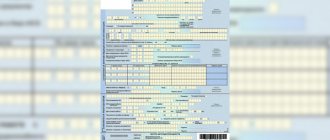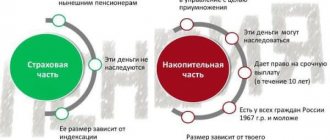The concept of non-insurance experience
According to Law 255-FZ of December 29, 2006 “On compulsory social insurance in case of temporary disability and in connection with maternity,” non-insurance service includes service in:
- various military formations (except for military and contract service);
- internal affairs bodies and similar structures;
- organizations that monitor the circulation of potent substances;
- FSIN, FSKN;
- Ministry of Emergency Situations;
- Russian Guard;
- fire protection service.
Periods of such work are not insurance, but are counted towards the total length of service. This is necessary for the correct calculation of benefits for temporary disability.
For the employer, information about non-insurance periods is needed for correct compensation of funds from the Social Insurance Fund.
Certifying documents to confirm non-insurance periods are:
- employment history;
- military ID;
- certificate from the government agency.
If the work was carried out under an employment contract, it also serves as confirmation of the non-insurance period.
Non-insurance intervals of activity are included in the total length of service.
How is work experience calculated from a work book? Method for determining the working period, formula
Since there are no special rules for accounting for “non-insurance” periods in the insurance period, such periods are counted into the insurance period in the general manner. Such periods include, in particular, military service. According to the law “On military duty and military service” (clause 2 of article 2 of the Federal Law of March 28.
Periods of study (receiving primary, secondary, higher education, including postgraduate studies, residency, internship), as well as periods of time during which the citizen was registered with the employment service as unemployed, are not included in the insurance period for assignment purposes benefits for temporary disability (neither as insurance nor as non-insurance periods).
- The employee served in the military or served in law enforcement;
- the employee received compulsory social insurance benefits for temporary disability;
- the entrepreneur worked for himself and paid his own fees, the same applies to notaries, lawyers, detectives;
- the person worked as a deputy or clergyman, a member of a collective farm or production cooperative;
- mother or father cared for a child up to 1.5 years old (but no more than 6 years in total);
- the unemployed received benefits at the labor exchange, participated in paid public works, and traveled to another area for employment in the direction of the labor exchange;
- the employee was unjustifiably prosecuted, suspended from work and placed in custody;
- the convicted person worked in prison and fulfilled his quota; the employee cared for a disabled person of group 1, an elderly person over 80 years old or a disabled child;
- the spouse of a contract serviceman lived in an area where it was impossible to get a job (but not more than 5 years in total);
- for spouses of consuls and employees of diplomatic services and missions abroad - periods of residence in another country, but not more than 5 years.
How to count
In the line “Non-insurance period” enter the exact time period when no insurance contributions were made (the exact number of calendar years and months). When calculating the non-insurance period, the following features are taken into account:
- if the periods of insurance and non-insurance periods coincide, one of them is taken into account in the sick leave, at the employee’s choice. This is confirmed by his written statement;
- when only the year and month are known when indicating the non-insurance period, the 15th is used to indicate the exact date.
img class=”aligncenter size-large wp-image-20025″ src=”https://ostr.online/wp-content/uploads/2017/12/slide_8-600×450.jpg” alt=”_” width= ”600″ height=”450″ /> The amount of the benefit for the general insurance period is the following part of the average earnings:
- from six months – the minimum minimum wage is paid;
- from 5 years – 60%;
- up to 8 years – 18%
- 8 years or more – 100%.
Non-insurance periods are subtracted from this length of service. Their significant duration reduces the final benefit amount. When making calculations, the HR employee takes into account only non-insurance periods after January 1, 2007. Until this time, the service time is included in the insurance period.
Read what is included in the insurance period here.
The non-insurance period indicated on the sick leave certificate is paid by the Social Insurance Fund. The exception is when the length of service determines the amount of the benefit.
https://youtu.be/Ed9w_0WfUDc
Do not confuse insurance and work experience
Select program
Seniority
Thus, the length of work experience in some cases may exceed the total duration of insurance, and if it is necessary to make any calculations based on length of service, the largest value is used.
Insurance experience
The insurance period should be understood as the total duration of the periods during which the employer made pension contributions and payments to the Compulsory Medical Insurance Fund for its employee.
There are two types of insurance experience:
- General: periods of work during which insurance contributions were made.
- Special: the sum of all periods of work under hazardous working conditions or in special climatic conditions.
Unlike work experience, the insurance period does not include periods of training, but several other factors are taken into account:
- Military service.
- Temporary incapacity for work on sick leave.
- Leave to care for children under 1.5 years of age with a total duration of no more than 6 years.
- Periods of detention provided that the person’s guilt has not been proven.
- An employee caring for a person over 80 years of age, a disabled person of the first group, or a disabled child.
- Duration of residence of spouses of military personnel at the place of their service in the absence of employment opportunities, but not more than 5 years.
- The duration of residence of spouses of employees of a consulate or diplomatic mission for a total duration of no more than 5 years.
Until 2002, the size of the pension was significantly influenced by length of service, but after the start of the pension reform, a different term was used - “insurance period”. The difference between them is as follows:
- Work experience is the total period of a citizen’s work activity. For it to be continuous, it was necessary to find a new job within one month after dismissal. Now this condition is irrelevant, and the very concept of continuity has been abolished. The main difference between work experience and insurance is that it includes absolutely any, incl. and social activities, while in the latter case, insurance payments are not transferred to the Pension Fund of the Russian Federation - accordingly, the length of service is not counted.
- The insurance period is, in fact, confirmation of a person’s work activity, during which he or his employer makes pension and medical contributions. The breaks between them do not matter, and the calculation takes into account only the number of months in which payments were made.
Despite the fact that now continuous work experience has actually been abolished, when calculating a pension, the time spent working in one position or in one department is still taken into account. The length of full service should also be taken into account: for women it is 20 years, and for men – 25 years.
If a citizen has worked the required number of years before retirement, the amount of old-age benefits will be 55% of average earnings.
If, upon reaching retirement age, he continues to work, then for each year of work 1% will be added to his pension, but the total increasing coefficient can be no more than 20%.
As is known, the length of work and insurance periods may differ from each other; accordingly, different methods for calculating them are used. To calculate work experience from a book, you must use the calendar method, that is:
- Take every 30 days for a full month worked.
- Count 12 months as a year.
- Write down on a separate sheet all the time periods of the employee’s work activity.
- Count each period and identify the total number of years, months and days worked.
- Add up all periods and get the amount of time worked (length of work experience).
To easily calculate your work experience, you need to adhere to the following rules:
- Write down all the periods in a column: this will make it easier to visually navigate while counting.
- Subtract one day from each date of dismissal of an employee if it falls on the date of subsequent hiring for a new job or position.
It should be taken into account that the length of service includes not only periods of work in certain positions, but also other things:
- Time for vocational training. Example: Seller Ivanova A.I. quit her job and was enrolled as a student at a medical college for a course in cosmetic massage. After studying for 5 months, she got a job in a massage parlor. The entire period of training will be included in her total work experience.
- Leave for childbirth and child care is also included in the length of service.
- The period of being registered with the employment center due to lack of work. At this time, citizens are paid unemployment benefits, but, nevertheless, it is taken into account in the total length of service.
- Leave to care for a disabled adult relative or disabled child is also not deducted from the total length of service.
Now there are many ways to calculate the length of employment and insurance periods, and one of the most popular is electronic. Its advantage is that to determine it, it is enough to indicate the dates of hiring and dismissal, as well as the date on which it is necessary to clarify the total length of service.
It is worth highlighting two methods of automatic calculation:
- Online calculators.
- Program 1C: for this you need to create a table, enter employment data from the book into it, and set a calculation formula.
To calculate your work experience manually yourself, you need to use the following algorithm:
- Open your work book and indicate on a blank sheet of paper the number of years spent studying at a university or secondary school.
- Add the period of military service (if any) to the years of training.
- Add the duration of maternity leave and all periods of official work.
- Sum up all terms.
When employing a new employee, the employer is obliged to conclude an employment contract with him and make appropriate entries in the work book. If a civil law contract was drawn up without an employment record, but contributions were made to the Pension Fund and the Compulsory Medical Insurance Fund, then the insurance period will be accrued. If this is not done, the employee’s length of service in the organization will not be counted.
To avoid such problems, you need to insist on official employment, otherwise it will be very problematic to prove your work activity in the company.
Nowadays, continuity of work experience is not mandatory, but previously permissible periods of absence from work depended on certain circumstances:
- In case of voluntary dismissal – 1 month before subsequent employment.
- Upon termination of employment contracts by employees working in the Far North, abroad - 2 months.
- For persons dismissed due to downsizing, reorganization or liquidation of an enterprise, a three-month period was established.
How to calculate continuous work experience:
- Enter the date of dismissal in the column on the piece of paper, subtract the date of employment.
- If the break does not exceed the established norms, add up the results. If it is longer than the time specified above, the line from the work book is not taken into account.
- If an employee quits 2 or more times within 1 year, then 12 months are not taken into account.
When continuous work experience is maintained:
- If an employee took leave to care for an HIV-infected child, but upon reaching his 18th birthday returned to work.
- If persons who retired due to length of service resumed their working activities.
In general, continuous work experience is calculated in calendar months and years, and if an employee violates the terms of continuity, he will not be counted.
As mentioned earlier, the period of maternity leave is included in the insurance period. Since 2014, the maximum duration of parental leave has increased from 3 to 4.5 years.
This is due to the fact that women are considered insured against maternity and disability - therefore, vacation must be taken into account in the length of service.
As in the case of maternity leave, the insurance period also includes periods of sick leave. To calculate the amount of temporary disability benefits, you need to focus on the number of years worked in the organization:
- Up to 5 years – 60% of average earnings are paid.
- From 5 to 8 years – 80%.
- Over 8 years – 100% of the average salary.
To calculate length of service during sick leave, you need to add up all the days on treatment and divide them by two.
All rules for calculating the insurance period are reflected in Art. 13 Federal Law No. 400 “On Insurance Pensions”, and they are as follows:
- All periods (military service, receiving unemployment benefits, etc.) when citizens did not work before registering as an insurer are included in the length of service based on the information contained in the Unified Personalized Accounting System.
- If documents confirming work activity were lost due to a natural disaster, citizens can bring two or more witnesses to confirm work in a particular organization.
To calculate this type of experience, it is enough to add up all the time periods during which insurance payments were made.
Despite the fact that the main document confirming a citizen’s work activity is a work book, you can also get a certificate of insurance experience from the Pension Fund, because This is where all the reliable information about the number of insurance payments is contained.
If there are incorrect entries in the work book, it is enough to contact the Pension Fund to resolve the problem.
If the work book is lost due to the fault of the employer or HR department employee, then the responsibility for restoring it rests with them. If the employee himself lost it, it is necessary to make a duplicate and visit the Pension Fund to make entries for the entire period of work.
It often happens that a citizen who has never worked has no work book. In this case, he may qualify for a minimum old-age pension. If work was carried out, but the book was lost, in order to receive the required amount of benefits, you need to start restoring it.
The main difference is that the length of service includes all vacation periods at your own expense. They will not be included in the insurance period, because at that time no insurance premiums were deducted for the employee.
- for less than 5 years of experience, the benefit is 60% of the salary;
- with 5-8 years of experience, the benefit is 80% of the salary;
- with more than 8 years of experience, the benefit is 100% of the salary.
- enter the periods of work from the employee’s work book in the “Periods for calculation” fields;
- if the employee was on parental leave, then include a period of up to 1.5 years in the calculation, but a period of more than 1.5 years is not included in the calculation;
- if the person worked as an entrepreneur, notary, private detective or farmer, take into account the period from the date of registration to the date of deregistration;
- include in the calculation the periods from the section “What periods are included in the length of service”, if any;
- if only the years of the beginning or end of work are known without exact dates, July 1 is taken as the date; if only the months of the beginning or end of work are known, the date is taken as the 15th (according to clause 27 of the Order of the Ministry of Health and Social Development of the Russian Federation of February 6, 2007 No. 91);
- if it is known that before 2007, for the same period, the insurance period was less than the continuous work experience calculated according to the Federal Law-255 algorithm, continuous work experience is taken into account for the calculation (resolution of the Federal Antimonopoly Service of the West Siberian District dated September 29, 2011 in case No. A70-1657 /2011).
Calculation example and payment
For example, a company employee has a total experience of 11 years as of November 2017. Of these, he served in the Ministry of Emergency Situations for 2 years, from 14.10. 2007 to November 15, 2009. The sick leave period is 7 days. Duration at current place of work is 9 years. An algorithm will help determine the non-insurance period and the amount of benefits:
- In the column “Non-insurance experience” the employee of the personnel department enters the period from 10/14/2007 to 11/15/2009. The non-insurance part of the length of service is 1 year 11 months.
- The non-insurance period is subtracted from the total length of service (11 years). The insurance period is 9 years and 8 months.
The amount of the disability benefit is 100%, since his insurance period is more than 8 years.
We recommend that you read about the payment of temporary disability benefits in this material.
Example of filling out a sick leave certificate
In the column “Insurance Guardian” enter the duration of 11 years.
The rules for calculating and confirming insurance experience can be found here.
What is the difference between work experience and insurance experience?
According to the Federal Law of December 15, 2001 No. 166-FZ “On State Pension Provision in the Russian Federation” (Article 2), length of service is the total duration of periods of work and other activities taken into account when determining the right to certain types of pensions under state pension provision, which are counted towards the insurance period for receiving a pension provided by Federal Law of December 28, 2013 No. 400-FZ “On Insurance Pensions”.
In accordance with the Federal Law of December 28, 2013 No. 400-FZ “On Insurance Pensions” (Article 3), the insurance period is the total duration of periods of work and (or) other activities taken into account when determining the right to an insurance pension and its amount, for which insurance contributions were accrued and paid to the Pension Fund of the Russian Federation, as well as other periods counted towards the insurance period.
Thus, from the definitions it follows:
| Seniority | Insurance experience |
| seniority is the length of periods of work; length of service is taken into account when determining the right to certain types of pensions; The length of service is counted towards the insurance period for receiving a pension. | insurance period – duration of periods of work; the insurance period is taken into account when determining the right to an insurance pension and its amount; During the insurance period, insurance contributions are calculated and paid to the Pension Fund of the Russian Federation. |
conclusions
Non-insurance periods on a certificate of incapacity for work are part of the length of service during which the employee does not make insurance payments. This is a period of service in military formations, the Ministry of Emergency Situations, fire protection, police departments and other structures. The duration of such periods is established according to the rules of general length of service. The presence of non-insurance experience is confirmed by entries in the labor, military ID or other document.
The non-insurance part of the length of service is noted in a special section of the sick leave certificate. Its size is taken into account when calculating temporary disability benefits. Payment for this period is carried out by the Social Insurance Fund.
What is insurance experience
Seniority is a complex legal aspect, striking with a sudden change or acquisition of rights to accrue pensions and benefits. There are several types of definition: special, general and labor insurance period.
The total insurance period is the totality of a citizen’s activities, during which mandatory contributions were paid to extra-budgetary funds, as well as other time intervals provided for by law. The calculation may take into account periods when an individual was not employed due to extenuating circumstances.
Insurance periods are considered to be:
- incapacity for work on sick leave with the right to accrue social benefits;
- time to care for a disabled person of the 1st group, a baby;
- useful work activity of a social nature with the provision of unemployment benefits;
- military activities under conscription, residence of family members of military personnel in areas in which it was impossible to carry out work activities.
In the latter situation, the state provided a maximum period of 5 years. Other time intervals will be counted only if the person was officially employed before or after them.
Special experience is a period of activity of a citizen in production with harmful conditions, in difficult climate conditions outside of Russia in a territory for which a special status is provided for the calculation of mandatory contributions.
Sample of filling out a certificate of incapacity for work
How is sick pay calculated?
The amount of disability benefits is calculated using a formula. The size of the payment can be determined by performing simple manipulations. The employee’s income received in the two years before the illness must first be divided by seven hundred and thirty (we get the average daily earnings). Then multiply by a certain percentage of average earnings (from 60% to 100%, the percentage of which depends on the insurance coverage). The resulting amount must then be multiplied by the number of calendar days during which the employee was sick.
When making calculations, it should be taken into account that the average daily earnings should not exceed the maximum and be less than the minimum value of the average daily earnings established in the year when the employee is paid. To calculate benefits in 2020, you must take the earnings from which insurance premiums were paid for 2013 (maximum average earnings - 568,000 rubles) and 2014 (maximum average earnings - 624,000 rubles). The maximum average daily earnings will be equal to: 568,000 rubles + 624,000 rubles: 730 days = 1,632.88 rubles.
The minimum amount of average daily earnings is calculated. based on the accepted minimum wage in the year the benefit was paid (the minimum wage for 2015 is 5,965 rubles). Therefore, it will be equivalent to: 5965 rubles x 24 months: 730 days = 196.11 rubles.
How non-insurance periods are filled out and calculated on sick leave in 2020
These indicators are reflected in a certain column in full (number of months and years). Their duration is determined in accordance with rules identical to the definition of the insurance period, and is confirmed by a military ID, work book, relevant certificate, etc.
Specific example:
Citizen A.O. Kardashov, who works at the Korona-L enterprise, went on sick leave from February 15 to February 25, 2020. How to establish a guard in order to calculate temporary benefits taking into account non-insurance cases and fill out the corresponding columns if the employee served in the internal affairs bodies from 12/25/1012 to 04/31/2015. He has been working at the company since July 1, 2015.
The solution of the problem:
- Insurance experience as of February 15, 2020. Duration of work in the bodies of A.O. Kardashova – 3.4 years. Based on the Law on Compulsory Social Insurance, Art. 16 No. 255 this time interval is included in the overall calculation. The period of work at the Korona-L enterprise is also added - 1.8 months. That is, the total period will be 5 years.
- The period from December 25, 2012 to April 31, 2020 is indicated in a certain column of the temporary disability sheet.
- Citizen A.O. Kardashov is due compensation - 80% of the amount of average earnings, since the total length of service is 7.8 years.
The accounting department and human resources department of the direct employer must understand that all non-insurance periods are paid for by an extra-budgetary fund. Additional funds will only be required if time of service affects the amount of the benefit.
Additional nuances
If the same time is associated with several places that are being counted, only one is chosen. To do this, the citizen draws up a written application. Breaks in work for calculating sick leave are practically irrelevant.
Any confirmation documents must include the following information:
- Work period.
- Description of the position.
- Address where duties were performed.
- Date of birth of the employee.
- FULL NAME.
- Number and date of issue.
The papers are usually transferred to the accounting department. Or another regulatory authority.
If the exact date is not indicated in the documents, then the countdown starts from the 15th. The average amount of compensation for temporary disability depends on the length of service during previous periods. The higher it is, the larger the payments. The highest rates are among those who, even with non-insurance periods, have worked for 5 years or more.
In any case, 100% will be paid to women who had maternity leave.
The more non-insurance periods, the lower the final amount of compensation will be.
Opening sick leave becomes an important point if your vacation coincides with illness. Without documents, it is impossible to confirm temporary disability. The validity of the documents begins from the first day of contacting doctors. And it doesn’t end until the issue itself is finally resolved.
Payment for sheets involves the following procedure:
- Calculate average earnings per day. We need to take the base for the previous two years, divide by the number 720.
- Next, calculate how much insurance experience you have.
- Benefits are being accrued, in a maximum of 10 days.
Non-insurance periods included in the insurance period
The current legislation of the Russian Federation establishes the following non-insurance periods included in the insurance period:
- from the beginning of 2001 to January 2003 for those citizens who carried out activities within the framework of advocacy or individual entrepreneurship on the territory of the Russian Federation;
- time of service taken into account when calculating pension payments for long service to a person;
- the period that is the last when assigning pension payments within the framework of disability - this applies to representatives of law enforcement and fire services, as well as to astronauts.
Since the beginning of January 2020, the length of the relevant length of service has changed. Now it is calculated using a new formula and can be at least 15 years . It is worth noting that this, for the most part, applies to those persons who entered into insurance relations with the state after the beginning of 2020. For all other persons, up to and including 2024, the minimum insurance period will increase by 1 year every 12 months .
It is worth noting that employers must register their employees properly, otherwise there will be no official wages, which means that this period of time will not be included in the insurance period and there will be no contributions to the Pension Fund of the Russian Federation. Also, if an employee was registered in accordance with all the rules, but does not receive all the funds legally, then less funds will be credited to the pension than expected.
Contributions differ only from that part of the salary that is officially registered. The higher the previously listed contributions, the greater the amount of points will be added to the amount of pension payments in the final version.
How to make the calculation correctly
The calculation of the relevant deadlines is regulated by current federal legislation. The calculation is based on the calendar dates of all types of activities that may be regulated by law. Within these limits, seasonal work can be counted for the calendar year.
It is also worth noting that from January 1, 2020, the insurance period began to be taken into account in points. At the time pension payments are accrued to a person, each point will be converted into a cash equivalent.
Confirmation of work experience, if it has not been documented, can be done with the direct participation of two or more witnesses. These persons can only confirm the existence of this period, but not the type of activity performed.
The lack of supporting documents may be directly related to emergency situations or to the deliberate destruction of papers carried out by third parties.
For non-work activities of a social nature, the following points can be awarded, which will be taken into account in the insurance period:
| Caring for people of retirement age or people with disabilities | 1.8 points in 12 months |
| For compulsory military service as part of the annual conscription | 1.8 points in 12 months |
| Maternity leave allocated to care for the first child | 1.8 points in 12 months |
| For the next child | 3.6 points |
| For the third and subsequent child | 5.4 points |
It is worth noting that if several types of activities coincide in the time frame that is suitable for the length of service, only one will be taken into account. For example, an individual is officially engaged in entrepreneurial activity, combining it with paid employment. In this case, the right to choose a priority activity remains with the applicant.
The following documents must be provided as a supporting list of documentation for calculating the insurance period:
- work book with records that must be prepared according to a certain standard;
- notifications and orders reflecting the real amount of wages;
- notification from the compulsory civil insurance authorities showing current information on the applicant’s registration;
- a certificate from the financial service or from the Pension Fund of the Russian Federation on the status of the personal account for individual entrepreneurs;
- certificates from medical institutions or social security authorities for caring for disabled people and children;
- documents from the regional office of the tax service and statements from a personal account in the Pension Fund for lawyers, lawyers and notaries;
- any other information upon request.
Which periods are counted and which are not?
In accordance with the laws of the Russian Federation, not all periods of activity of the person who applies for the calculation of the insurance pension are taken into account. In addition to the period of work under the contract, the insurance period also includes other periods of time in accordance with the person’s activities. The moments when the insurance period, on the contrary, is not accrued are determined.
Periods of enrollment/non-enrollment of insurance experience:
- If at the time of activity under the employment contract a pension for disability or temporary loss of ability to work was accrued, then this period is not included in the accrual.
- The period of military service.
- The time that was defined as caring for a child up to 1.5 years old is included in the accrual.
- Payments that a person received for unemployment have contributions to the insurance fund, so this period of time is taken into account.
- When a person participates in public works or activities that were paid officially with the withholding of the appropriate tax, a deduction is made.
- In connection with the move, which was provoked by the Employment Center in order to get a person a job, the time is taken into account in the insurance period.
- If a person was convicted and was in prison, and then acquitted, then the time of imprisonment will automatically turn into insurance period.
- Officially confirmed care for the elderly over 80 years of age and the disabled from childhood is included in this type of experience.
- If one of the spouses is military and resides in a region where the second of the couple cannot get a job, then accrual is made, but not more than 5 years.
- If the married couple is abroad and works at the consulate, then the accrual will be made.
All controversial points must be clarified. All activities must be officially documented, with a certain percentage deducted from benefits and wages.












